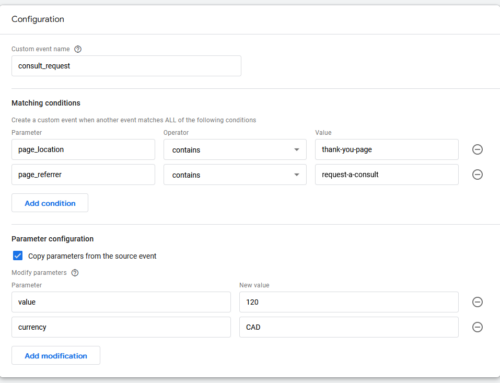The objective value of a visitor to your site is a fundamental and critical metric that every business should know. This value can show you what different types of market campaigns contribute to your revenue and profits. In turn, this will help you decide which new campaigns are worth implementing.
Yet, it can be challenging for many companies to estimate this value for a number of reasons. For one thing, many companies don’t track or associate which sales come from which marketing effort.
Depending on what your business model is you can use various tools (many in Google Analytics) to track your revenue for each program. Here’s how to collect your source data.
eCommerce
If you’re selling online your sales are easy to track and calculate. First, set up unique campaign codes for each of your ad links, this is automatically set up for Google Adwords but will need to be customized for other forms of advertising. Google provides a URL builder tool to help generate the unique tracking codes. With this in place, you can easily obtain revenue reports by various dimensions such as keyword, landing page, ad type, ad and more from Google Analytics Conversions/eCommerce/Overview. It’s really just this simple.
Selling Advertising
If your site is monetized through advertising you should be keeping track of your monthly revenue from each of your advertisers and calculating click-through rates and revenue per click or eCPM. Unfortunately, Google Analytics and other tools do not do a very good job of tracking inbound conversions or click-throughs to external advertisers so you’re not going to know which traffic sources are converting better than others. It is a safe bet, however, that organic search traffic will convert substantially higher than most other traffic types.
One (very imperfect) way to calculate the relative value of your various traffic types in this scenario is to use the pages per visit as a factor. Let’s say your organic traffic average is 2.85 PPV, your referral traffic is 1.70 PPV and your direct traffic is 2.20 PPV. Let’s also say that your total monthly ad revenue is $8,500 from 50,000 visitors ($0.17/visit).
First add up the total PPV = 6.75 (2.85 + 1.70 + 2.20).
To calculate the approximate value of any traffic type divide it’s PPV by total PPV and multiply by number of different traffic types; finally multiply that factor by the standard revenue/visit.
To calculate the revenue/visit for organic search traffic (2.85 / 6.75 x 3) = 1.27 x $0.17 = $0.2159.
This is just an estimate but it will certainly get you much closer to the real value for each traffic type.
Selling Products or Services Offline
Ok, you’re not selling online, so how do you know how much revenue you are generating?
If you generate more than 10 new leads each month we strongly suggest you use some kind of CRM tracking software; there are hundreds if not thousands of solutions for all types and sizes of business. If you have less than 10 leads/month a shared spreadsheet should do nicely… in this case, we suggest using Google Apps since you’ll be able to collaborate on it with colleagues and avoid version control nightmares.
Here we will assume you have a call-to-action offer on your website to generate leads and that your staff have all be trained to ask where prospects heard about your business when they call or email you directly.
Assuming you follow CRM best practices you can now track your web-based leads through to sales and calculate both your periodic web revenue and the total lifetime sales per customer. To estimate what each lead is worth simply take your average lifetime sales per client, multiply that by number new clients converted each month and divide that by the number of leads generated per month. Let’s assume each client generates $2,500 in total revenue, you sign up 4 new clients each month out of 100 leads. Therefore each lead is valued at $100 ($2500 x 4 / 100). You can use a different reporting period to make the calculation keeping in mind that the period should reflect your current business trends.
In order to obtain performance reports by ad campaign simply create one or more goals in Google Analytics for your lead generating form(s) and you’ll be able to track which traffic sources are generating the most leads. In the example above we determined each lead is worth $100 so use that figure for your goal. Your reports will be available in Google Analytics at Conversions/Goals/Overview.
Calculating Revenue Per Visitor
Once you’ve implemented the appropriate process for calculating your monthly web generated revenue simply divide your total revenue by the number of unique visits in the same period. For example, if your total revenue in December was $10,000 and you had 25,000 visitors your revenue per visitor is $0.40 ($10,000 / 25,000).
What does this tell you? Well for one it is a variable that can be used to determine an expected ROI for different ad campaigns. For another, it can be used to monitor whether your conversion performance is increasing or decreasing over time… i.e. for a given amount of traffic are you selling better or worse than before.
Estimating ROI
Let’s say an SEO company has offered you a campaign where they estimate you’ll get 5,000 new visitors per month once they are done working their magic. They want $7,500 to implement the project and tell you your improved rankings will last for 6 months without maintenance work. Assuming they do what say they can do and using your figures from above you will yield $2,000 ($0.40 X 5,000) in new revenue per month or $12,000 in total ($2,000 x 6 months). Let’s also say you are selling goods that cost (COGS) $3,000 to produce.
Therefore your Gross Profit = $12,000 – $3,000 = $9,000
and your ROI = ($9000 – $7,500) / $7,500 = 0.2
Frankly, it’s just not very good. When you’re done and everything has gone perfectly you only stand to earn about $1,500 after marketing expenses. This is way too risky!
A Deeper Dive Into Traffic Value
Ok, the scenario above doesn’t look very good, but we estimated the revenue using the overall revenue per visitor for your site. Let’s face it, not all traffic is of equal quality.
Using the eCommerce example from above break out your monthly metrics by source including revenue, traffic and revenue per visitor calculation:
Organic search = $5,000 / 7,000 = $0.71/visit
PPC SEM = $2,000 / 4,000 = $0.50/visit
Referral and Other = $3,000 / 11,000 = $0.27/visit
See how much higher value the organic traffic is, great! Now let’s input that back into the SEO formula which yields $3,550 ($0.71 x 5,000) for a total of $21,300 ($3,550 x 6 months).
Therefore your Gross Profit = $21,300 – $3,000 = $18,300
and your ROI = ($18,300 – $7,500) / $7,500 = 1.44
Much better! You now stand to make $10,800 after marketing expenses.
Summary
Figuring out what your traffic is worth can be a bit time consuming but is well worth it in the end. Use these methods for your own site and let us know how well your results align with your expectations.
Need help with implementing this, check out our Search Engine Optimization services.






